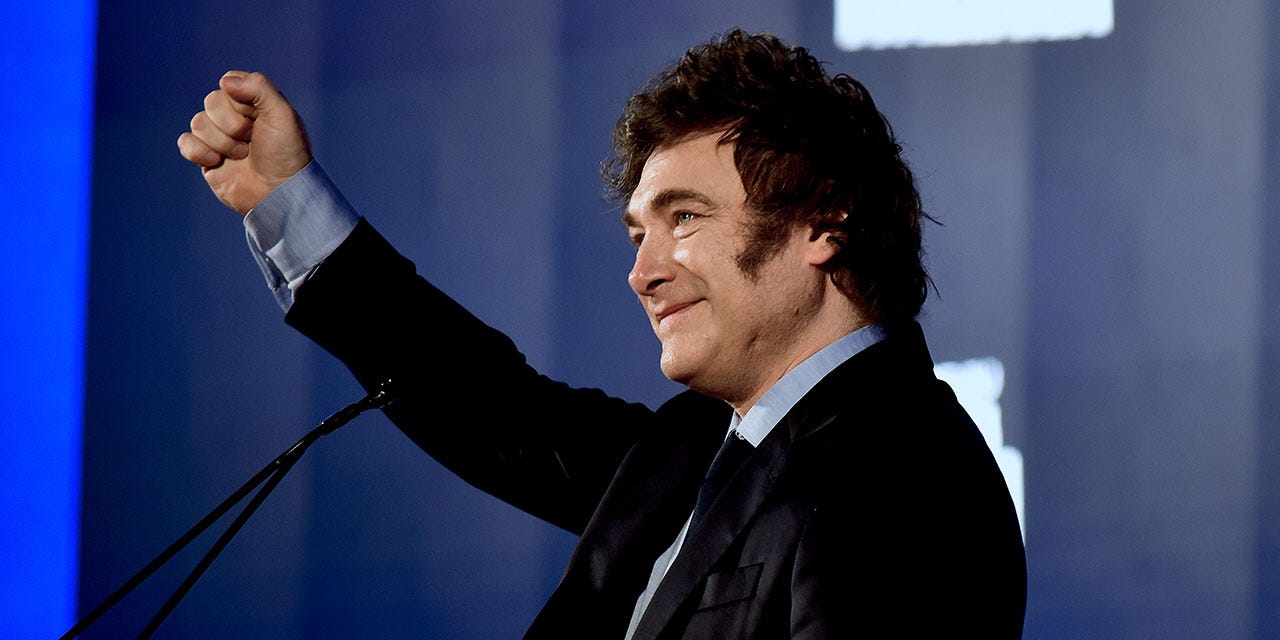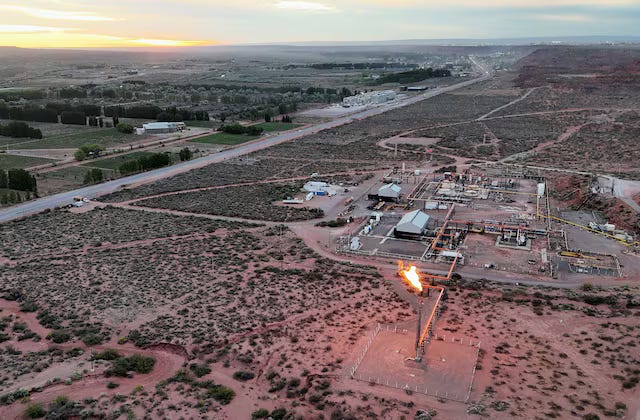Chainsaw Capitalism
A libertarian chainsaw, a mining boom, and a dirt-cheap oil giant...could Argentina’s chaos finally be investable gold? Or just another tango with disaster?
If a country spends enough decades screwing things up, the outside world eventually stops paying attention. Argentina is one of those countries.
A gorgeous landmass smothered in natural resources and cursed by generationally bad economic policy, it’s become a sort of punchline in international finance…“emerging market” in name only, perpetually on the edge of collapse.
But something strange is happening.
In November 2023, the people of Argentina handed a metaphorical chainsaw…and then a literal one…to Javier Milei, a shaggy-haired libertarian economist turned political wrecking ball.
His promise? Cut the bloated state to the bone.
One year later, the results aren’t just surprising…they’re jaw-dropping.
If you believe in free markets, fiscal discipline, and the power of a simple tax code, what’s happening in Argentina isn’t just interesting.
It’s a flashing neon investment signal…and possibly the beginning of the biggest emerging market comeback of the 21st century.
Let’s follow the money.
The Miracle Nobody Saw Coming
Argentina didn’t stumble into this moment…it limped, wheezing, out of a self-inflicted disaster zone.
When Milei took office in December 2023, the country was an economic dumpster fire.
Inflation was running at 289%.
The peso was worth about as much as the paper it was printed on. Half the population was in poverty.
The government budget looked like it had been drawn up by a toddler with a crayon and a caffeine addiction.
And yet…12 months later…something remarkable has happened.
Government spending is down 28%.
The trade balance flipped from an $8 billion deficit to an $18.5 billion surplus—the largest in Argentina’s history.
Inflation, once galloping at 25% monthly, is now crawling around 2.4%.
And most shocking of all: Argentina posted a budget surplus in Q1 2024 for the first time since 2008.
No central bank trickery. No bailout magic. Just good, old-fashioned austerity with a side of radical deregulation.
It’s painful, of course. Milei’s shock therapy has caused real short-term damage…unemployment is up, and real wages are still recovering. But the early results are too big to ignore.
Even poverty is retreating. From a peak of 53%, it’s dropped to 38.1%, with extreme poverty cut in half.
That’s not just numbers. That’s people crawling out of the economic grave.
Milei’s Betting Big on Rocks
So where does Milei think the real treasure lies?
Under the ground.
Argentina has long been known for its farming and footballers, but beneath the surface lies a geological jackpot: the world’s 4th-largest lithium reserves, massive copper deposits, and plenty of gold and silver to boot.
For decades, these minerals might as well have been buried on the moon…trapped behind capital controls, red tape, and regulatory insanity.
Enter Milei’s RIGI…the Régimen de Incentivo para Grandes Inversiones…passed in mid-2024.
It’s one of the most investor-friendly mining regimes anywhere in the world.
Highlights:
Corporate tax rate cut from 35% to 25% for 30 years.
Export and import taxes slashed, especially on mining gear.
Repatriation of profits guaranteed.
Regulatory framework frozen for three decades.
Think about that. In a world where resource nationalism is spreading faster than a meme stock on Reddit, Milei is offering thirty years of policy stability.
Predictably, the capital is flooding in.
In October 2024, BHP and Lundin Mining ponied up $3.25 billion to acquire Filo Corp, a copper-lithium explorer in Argentina’s north. It won’t be the last check that clears.
In the great battery mineral arms race, Argentina just grabbed a seat at the grownups’ table.
But capital flows aren’t the only story worth watching. What happens when the state oil giant starts acting like a capitalist machine?
YPF: Dirt-Cheap Energy Giant
Now let’s talk about the most obvious asymmetric bet in the entire Milei-verse: YPF, the state-run oil and gas major sitting atop one of the largest shale formations on Earth…Vaca Muerta.
At time of writing, YPF trades at $30.44, with a forward P/E of 4.8x. That’s about a third of ExxonMobil or Chevron.
Sure, the stock’s pulled back from a 2024 high near $47, but it’s also nearly doubled from its 2023 lows.
So, what gives? Is the run over?
We don’t think so. Not even close.
Milei’s energy strategy is a page ripped straight from the Texas playbook. He’s lifting price caps, deregulating exports, and setting the stage for privatization.
Whether that means selling off YPF whole or carving it up and spinning off pieces, the path is clear: unlock value.
Here’s what makes YPF so compelling:
Vaca Muerta is a monster…world-class shale with breakeven costs under $40/barrel.
New pipelines coming online in 2025–26 will allow Argentina to hit 1 million barrels per day, and YPF is central to that ramp.
The government wants out…or at least, out of the way.
If privatization moves forward post-October midterms, expect fireworks.
Even with no change, just re-rating to a more rational 8–10x P/E puts the stock at $60–80. That’s a double-plus.
Risks? Sure. Congress could block reforms. Equipment shortages may drag. Oil prices could nosedive. But that’s already baked into the valuation. This is what asymmetry looks like.
Banco Macro: Lending into the Boom
Argentina hasn’t just underinvested in energy and mining…it’s also been running on financial fumes.
Enter Banco Macro, one of Argentina’s largest private banks. It trades at $89.23, with a forward P/E of 4.35x.

That’s cheaper than JPMorgan. Cheaper than Wells Fargo. Cheaper than most hardware stores.
Why? Because for decades, Argentine banks haven’t really done banking.
Capital controls, inflation, and government dysfunction turned them into glorified currency warehouses.
That’s changing.
Milei’s tearing down the “cepo”…the capital control framework that strangled credit.
Inflation is falling. GDP is projected to grow 5–6% in 2025, led by industrial expansion.
That means loans. That means deposits. That means spreads.
The credit cycle in Argentina is like a compressed spring. And Banco Macro is positioned perfectly to get launched.
Of course, the spring could snap.
If inflation roars back, or if the peso collapses after controls are lifted too fast, banks will feel it.
Midterm political gridlock could stall reforms. And the scars of Argentina’s past defaults are still fresh.
But again…at 4.35x earnings, how much good news needs to happen for you to make money?
Not much.
A rerating to 9x…still conservative…takes Banco Macro to $180+, more than a double.
Why It Matters (and Why It Might Fail)
Argentina’s rebirth isn’t just about tax rates and P/E multiples.
It’s a philosophical throwdown.
Milei is proving…in real time…that free markets, fiscal restraint, and policy stability work.
His administration has eliminated ministries, balanced the budget, and kept the IMF at arm’s length while negotiating debt relief—all while lowering poverty.
And it’s not just theory anymore. It’s showing up in the data. In earnings. In valuations.
But don’t mistake this for a done deal.
Milei’s coalition is weak: 38 out of 257 seats in the lower house, just 7 of 72 in the Senate. Every reform is a knife fight.
The October 2025 midterms are critical. If Milei wins more seats, he’ll have a mandate to keep slashing. If not, the bureaucracy might regroup and grind him down.
Then there’s the currency. The peso is still overvalued. Inflation ran at 117% in 2024, but the currency only depreciated 30%.
That kind of mismatch doesn’t last forever. A devaluation could sting.
And let’s not forget the ghosts of crises past.
In the 1990s, Argentina liberalized too fast, dollarized its economy, and wound up in a brutal 2001 collapse. History rhymes, especially here.
How to Invest (Without Getting Burned)
Argentina is not for the faint of heart.
But for the prepared investor, this could be a generational opportunity.
Here’s the playbook:
Focus on asymmetry. YPF and Banco Macro trade at such low multiples that even partial reform success could deliver 2–3x returns.
Diversify globally. Don’t go all-in on Buenos Aires. Keep Argentina a slice, not the pie. It’s Asymmetric Investing 101.
Track political milestones. Watch the October 2025 midterms, the lifting of capital controls (cepo), and any movement on IMF restructuring.
Have an exit plan. This isn’t a forever hold. If reforms stall or the peso implodes, you’ll want to get out before the next tango turns tragic.
Chainsaw Optional, Opportunity Real
Argentina is no longer just the country that could have been. It’s now the country that might finally be.
With one of the boldest economic experiments in modern history underway…and the early results shockingly positive…it’s time for investors to look south.
YPF is cheap energy. Banco Macro is cheap credit. The mining sector is catching fire. And Milei? He’s the wildcard that just might win.
There will be volatility. There will be drama. But there will also be opportunity…real, tangible, portfolio-changing opportunity.
And if it all works?
Well, let’s just say you won’t need a chainsaw to cut through the returns.
The Big Five
Five deep value ideas that you probably wouldn’t have heard of before let alone considered.
These aren’t trade ideas as such, but if you were to take each position and short them in equal weights and hold those short positions for five years, you would most likely be taken to the cleaners, which answers the question of whether or not they would be a good investment.
Please read our important disclaimer here regarding any recommendations.
Honghua Group
Chu Kong Petroleum
Northern Dynasty Minerals
Rhodium
Wilhelmsen
⭕️ The Deep Dive on the Big 5 is available in our latest premium report!
Disclaimer: Not investing advice! This article is for educational purposes only. Seriously, we really do hope you become a better investor after reading our work. But always do your own due diligence and/or consult with a financial professional before making any investment. Capitalist Exploits reserves all rights to the content of this publication and related materials.






